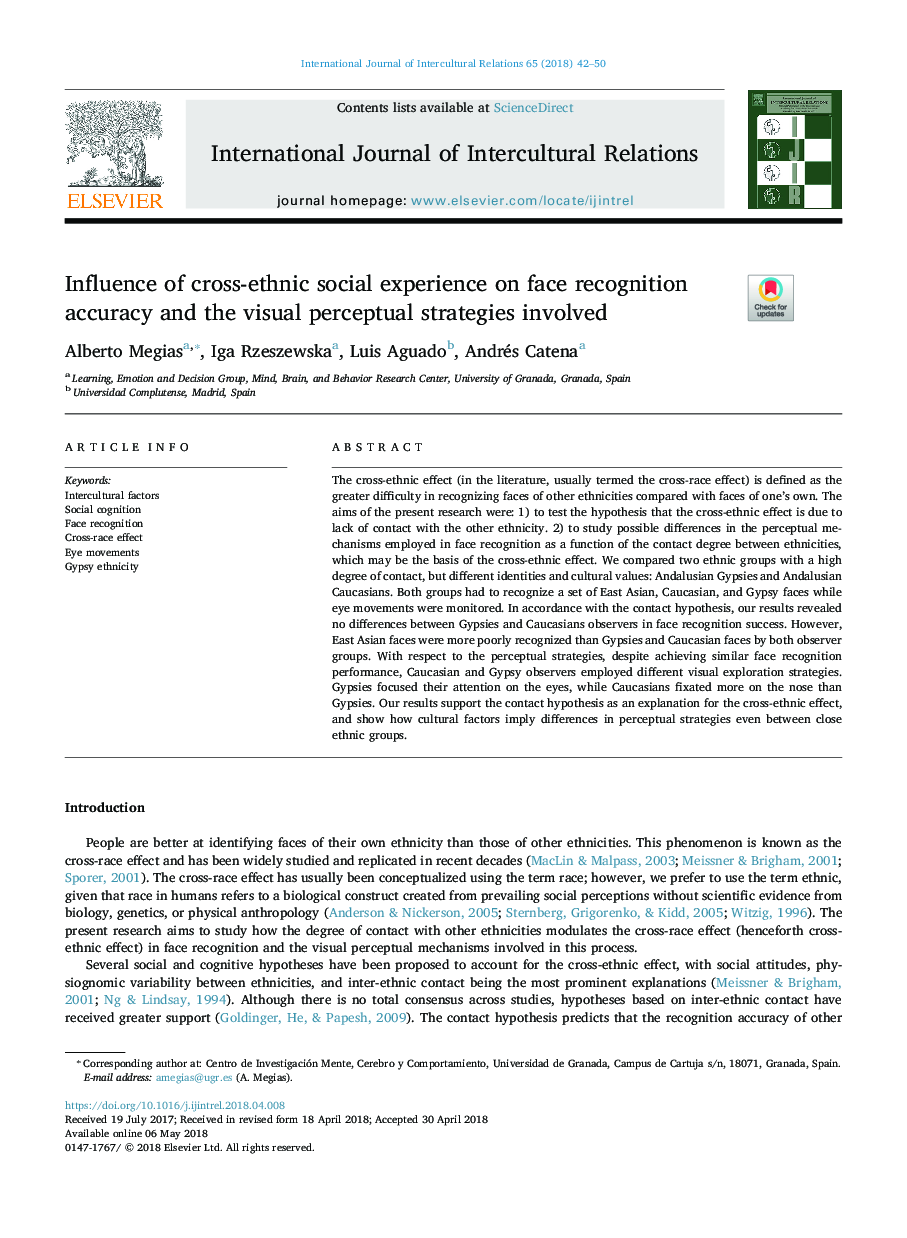| کد مقاله | کد نشریه | سال انتشار | مقاله انگلیسی | نسخه تمام متن |
|---|---|---|---|---|
| 7323604 | 1475725 | 2018 | 9 صفحه PDF | دانلود رایگان |
عنوان انگلیسی مقاله ISI
Influence of cross-ethnic social experience on face recognition accuracy and the visual perceptual strategies involved
ترجمه فارسی عنوان
تأثیر تجربه اجتماعی متقابل قومی بر دقت تشخیص چهره و راهبردهای ادراکی بصری درگیر
دانلود مقاله + سفارش ترجمه
دانلود مقاله ISI انگلیسی
رایگان برای ایرانیان
کلمات کلیدی
عوامل فرهنگی، شناخت اجتماعی، تشخیص چهره، اثر متقابل نژاد، حرکات چشم، قومی کولی،
ترجمه چکیده
اثر متقابل قومی (در ادبیات، معمولا به عنوان یک اثر نژادی) نامیده می شود به عنوان مشکل بزرگ در شناخت چهره های دیگر قومیت ها در مقایسه با چهره خود. هدف از تحقیقات حاضر، عبارت بود از: 1) تست فرضیه ای مبنی بر اینکه اثر متقابل قومی ناشی از عدم ارتباط با قومیت دیگر است. 2) بررسی تفاوتهای ممکن در سازوکارهای ادراکی مورد استفاده در شناخت چهره به عنوان عملکردی از درجه تماس بین قومیت ها، که ممکن است مبنای اثر قومی باشد. ما دو گروه قومی را با درجه بالایی از تماس مقایسه کردیم، اما هویت های مختلف و ارزش های فرهنگی: کولی اندلس و قفقاز اندلس. هر دو گروه باید مجموعه ای از چهره های شرق آسیا، قفقازی و کولی را تشخیص دهند در حالیکه حرکات چشم تحت نظارت بودند. مطابق با فرضیه تماس، نتایج ما نشان دهنده تفاوت بین کولی ها و ناظران قفقازی در موفقیت در تشخیص چهره نیست. با این حال، چهره های شرق آسیا توسط هر دو گروه ناظر شناخته شده اند نسبت به کولی ها و قفقازی ها کمتر شناخته شده اند. با توجه به استراتژی های ادراکی، با وجود رسیدن به عملکرد مشابه تشخیص چهره، ناظران قفقازی و کولی، راهبردهای اکتشافی بصری مختلف را مورد استفاده قرار دادند. کولی ها توجه خود را به چشم ها متمرکز کردند، در حالی که قفقازی ها بیشتر از کولی ها در بینی قرار داشتند. نتایج ما از فرضیه تماس به عنوان یک توضیح برای اثر قومیتی حمایت می کند و نشان می دهد که چگونه عوامل فرهنگی تفاوت های استراتژیک ادراکی را حتی در میان گروه های قومی نزدیک نشان می دهد.
موضوعات مرتبط
علوم انسانی و اجتماعی
مدیریت، کسب و کار و حسابداری
کسب و کار و مدیریت بین المللی
چکیده انگلیسی
The cross-ethnic effect (in the literature, usually termed the cross-race effect) is defined as the greater difficulty in recognizing faces of other ethnicities compared with faces of one's own. The aims of the present research were: 1) to test the hypothesis that the cross-ethnic effect is due to lack of contact with the other ethnicity. 2) to study possible differences in the perceptual mechanisms employed in face recognition as a function of the contact degree between ethnicities, which may be the basis of the cross-ethnic effect. We compared two ethnic groups with a high degree of contact, but different identities and cultural values: Andalusian Gypsies and Andalusian Caucasians. Both groups had to recognize a set of East Asian, Caucasian, and Gypsy faces while eye movements were monitored. In accordance with the contact hypothesis, our results revealed no differences between Gypsies and Caucasians observers in face recognition success. However, East Asian faces were more poorly recognized than Gypsies and Caucasian faces by both observer groups. With respect to the perceptual strategies, despite achieving similar face recognition performance, Caucasian and Gypsy observers employed different visual exploration strategies. Gypsies focused their attention on the eyes, while Caucasians fixated more on the nose than Gypsies. Our results support the contact hypothesis as an explanation for the cross-ethnic effect, and show how cultural factors imply differences in perceptual strategies even between close ethnic groups.
ناشر
Database: Elsevier - ScienceDirect (ساینس دایرکت)
Journal: International Journal of Intercultural Relations - Volume 65, June 2018, Pages 42-50
Journal: International Journal of Intercultural Relations - Volume 65, June 2018, Pages 42-50
نویسندگان
Alberto Megias, Iga Rzeszewska, Luis Aguado, Andrés Catena,
